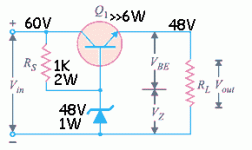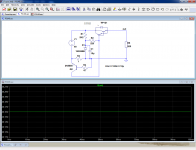Hi, I need to obtain a regulated voltage of 48V (at least 500 mA) from a unregulated PSU of about 60V. This one is derived from a transformer with dual secondary outputs, one 10 VAC the other 28 VAC, both delivering 2 A (thus having 38 VAC properly linked).
I can have essentialy two options I think:
1) LM2576HVT
2) LM317HV or TL783.
Any other suggestion instead these ones? Thanks.
I can have essentialy two options I think:
1) LM2576HVT
2) LM317HV or TL783.
Any other suggestion instead these ones? Thanks.
As you have no more than 60V-48V=12V across the regulator, an ordinary LM317 can do unless you risk overload of the regulator output.
10Vac+28Vac is in the low end for 60Vdc rectified. In particular when you pull 0.5A.
Yes it was the first thing I thought and bought from ebay a LM317HV but not worked (maybe faulty or chinese trash). In the past I used combination of mosfet and bjt for higher voltage but lower current successfully.
As you have no more than 60V-48V=12V across the regulator, an ordinary LM317 can do unless you risk overload of the regulator output.
10Vac+28Vac is in the low end for 60Vdc rectified. In particular when you pull 0.5A.
I agree.
An LM317T heatsinked properly would be my choice, and I've done these many times.
A 270 ohm off the output in series with a 10 or11K resistor to ground, and the junction of the resistors to the "adjust' terminal on the LM317T.
Adding a 10u cap across the 10 or 11K helps stability.
A transitorized zener regulator, simple, good...but doesn't the zd add some "noise" for the amp circuit?
...and will also kill a regular 317: it will act as a slow start, meaning the regulator will see the whole input voltage during startup.Adding a 10u cap across the 10 or 11K helps stability.
Using a floating, low-voltage reg in high voltage applications on the pretext that it only sees the difference voltage works well on paper, in sim, but not so well in reality.
A TL783 is more sensible solution, but if high performances aren't required, a simple transistor+zener reg is perfectly sufficient.
It can be protected if it needs to, and the zener can be bypassed to shunt its noise
...and will also kill a regular 317: it will act as a slow start, meaning the regulator will see the whole input voltage during startup.......
True as always but it can be protected with a power zener from input to output and the reverse protection diode from output to the reference pin being replaced by a low voltage zener. A possibility.
I agree.
An LM317T heatsinked properly would be my choice, and I've done these many times.
A 270 ohm off the output in series with a 10 or11K resistor to ground, and the junction of the resistors to the "adjust' terminal on the LM317T.
Adding a 10u cap across the 10 or 11K helps stability.
Well, it still is 60V-48V=12V -> 12V*0.5A=6W of heat that heeds to get dissipated.
Assuming an ambient temperature of 40°C max and an RTHjc of 5°C/W for the LM317 we still have to deal with 125Tjmax - 40°C - 5°C*6W = 55°C for the heatsinks calculation. So the heatsink must be better than 55°C/6W = 9.17K/W to get the job done at full load and running the LM317 at 125°C junction temperature. I wouldn't recommend that.
A reasonable "big" heatsink with 3-4K/W would be adequate for temperatures like:
40°C + 3K*6W = 58°C (barely to touch - 40°C + 4K*6W = 64°C
So forget about getting away with a flimsy TO-220 metall sheet heatsink like these:
https://www.mouser.de/datasheet/2/670/hss-b20-np-12-1312554.pdf
You may get away with these if you only have 0.5A peak requirements and a much lower steady current demand.
Just saying.
The diodes will not protect against this condition, you would need a transil across the regulator.Elvee definitely is right - it is better to do it without 10u caps, or make it with all two reverse protection diodes, as it is in the datasheet.
Here is an example of simple regulator, equipped with an overcurrent protection and a zener bypass:
Attachments
...and will also kill a regular 317: it will act as a slow start, meaning the regulator will see the whole input voltage during startup.
Using a floating, low-voltage reg in high voltage applications on the pretext that it only sees the difference voltage works well on paper, in sim, but not so well in reality.
A TL783 is more sensible solution, but if high performances aren't required, a simple transistor+zener reg is perfectly sufficient.
It can be protected if it needs to, and the zener can be bypassed to shunt its noise
As I previously mentioned, I specified an LM317T regulator.
Well, it still is 60V-48V=12V -> 12V*0.5A=6W of heat that heeds to get dissipated.
Assuming an ambient temperature of 40°C max and an RTHjc of 5°C/W for the LM317 we still have to deal with 125Tjmax - 40°C - 5°C*6W = 55°C for the heatsinks calculation. So the heatsink must be better than 55°C/6W = 9.17K/W to get the job done at full load and running the LM317 at 125°C junction temperature. I wouldn't recommend that.
A reasonable "big" heatsink with 3-4K/W would be adequate for temperatures like:
40°C + 3K*6W = 58°C (barely to touch - 40°C + 4K*6W = 64°C
So forget about getting away with a flimsy TO-220 metall sheet heatsink like these:
https://www.mouser.de/datasheet/2/670/hss-b20-np-12-1312554.pdf
You may get away with these if you only have 0.5A peak requirements and a much lower steady current demand.
Just saying.
You must have not read the part where I stated: "An LM317T heatsinked properly......"
I think you mean LM317HV (=LM317HVT)As I previously mentioned, I specified an LM317T regulator.
I think you mean LM317HV (=LM317HVT)
No, I stated LM317T.
LM317T: 3-Terminal 1.5 A Positive Adjustable Voltage Regulator
But we are talking about 60V input. (?)No, I stated LM317T.
It's too much for usual LM317T.
But we are talking about 60V input. (?)
It's too much for usual LM317T.
The OP requires only a 12 volt drop from 60V to a regulated 48V, so there's no problem.
The LM317T would only be absorbing 12 volts, so where is the problem?
- Status
- This old topic is closed. If you want to reopen this topic, contact a moderator using the "Report Post" button.
- Home
- Amplifiers
- Power Supplies
- 48 VDC from 60 V unregulated

